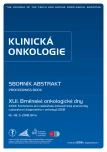Can Analysis of Cellular Lipidome Contribute to Discrimination of Tumour and Non-tumour Colon Cells?
Authors:
J. Hofmanová 1; J. Slavík 2; Z. Tylichová 1,3; P. Ovesná 4; J. Bouchal 5; Z. Kolář 5; J. Ehrmann 5,6; M. Levková 5; M. Machala 2; J. Vondráček 1; A. Kozubík 1
Authors‘ workplace:
Oddělení cytokinetiky, Biofyzikální ústav AV ČR, v. v. i., Brno
1; Výzkumný ústav veterinárního lékařství, v. v. i., Brno
2; Ústav experimentální biologie, PřF MU, Brno
3; Ústav biostatistiky a analýz, LF MU, Brno
4; Ústav klinické a molekulární patologie, LF UP v Olomouci
5; Ústav histologie a embryologie, LF UP v Olomouci
6
Published in:
Klin Onkol 2018; 31(Supplementum1): 151-154
Category:
Article
Overview
Backgrounds:
Colon cancer development is often characterized by abnormalities in lipid synthesis and metabolism, which may influence energetic balance, structure and function of biological membranes, or production of specific mediators and cell signalling. The changes in lipid profile and metabolism (lipidome) may significantly affect cell behaviour and response to therapy. Permanent epithelial cell lines at various stages of cancer development are used for better understanding of this topic on cellular and molecular levels. In our study, we hypothesized that detailed analyses of colon cancer cell line lipidomes may help to identify major alterations in the amount and profile of specific lipid classes/species, which can contribute to their different response to various stimuli.
Material and Methods:
Cellular lipids were isolated from six human epithelial cell lines derived from tissues at various stages of tumour development. Liquid chromatography coupled with tandem mass spectometry analyses were performed in order to determine amount and mass profiles of all phospholipid (PL), lysophospholipid (lysoPL) and sphingolipid classes. The data was statistically evaluated (cluster and discrimination analyses) with respect to mutual comparison of cell lines and to significantly discriminating lipid types.
Results:
The results of cluster analysis arranged cell lines in order corresponding to their level of transformation (normal cells, adenoma, carcinoma and lymph node metastasis). The results of discrimination analyses revealed the most discriminating lipid types and distinction in PL: lysoPL ratios. Particularly, significant correlation of the amount and profiles of both specific lysoPL and sphingolipid classes with cell transformation level were observed. Similar approaches are now applied to compare lipidomes of colon epithelial cells isolated from tumour vs. non-tumour samples of colon cancer patients.
Conclusion:
Our results indicate that a) selected cancer cell lines are suitable model for lipidomic studies that can serve as a basis for subsequent clinical research, b) cellular lipidome analyses may help to discriminate tumour and non-tumour cells in clinical samples, where specific types of lipids could serve as biomarkers.
Key words:
colon cancer – cell lines – liquid chromatography – mass spektrometry – phospholipids – sphingolipids – bioinformatics
The authors declare they have no potential conflicts of interest concerning drugs, products, or services used in the study.
The Editorial Board declares that the manuscript met the ICMJE recommendation for biomedical papers.
This work was supported by Czech Health Research Council, grant No. AZV 15-30585A.
Submitted:
19. 3. 2018
Accepted:
18. 4. 2018
Sources
1. Santos CR, Schultze A. Lipid metabolism and cancer. FEBS J 2012; 279 (15): 2610–2623. doi: 10.1111/j.1742-4658.2012.08644.x.
2. Gassler N, Klaus C, Kaemmerer E et al. Modifier-concept of colorectal carcinogenesis: Lipidomics as a technical tool in pathway analysis. World J Gastroenterol 2010; 16 (15): 1820–1827.
3. Yan G, Li L, Zhu B et al. Lipidome in colorectal cancer. Oncotarget 2016; 7 (22): 33429–33439. doi: 10.18632/oncotarget.7960.
4. May-Wilson S, Sud A, Law PJ et al. Pro-inflammatory fatty acid profile and colorectal cancer risk: A Mendelian randomisation analysis. Eur J Cancer 2017; 84: 228–238. doi: 10.1016/j.ejca.2017.07.034.
5. Hofmanová J, Slavík J, Ovesná P et al. Dietary fatty acids specifically modulate phospholipid pattern in colon cells with distinct differentiation capacities. Eur J Nutr 2017; 56 (4): 1493–1508. doi: 10.1007/s00394-016-1196-y.
6. Tylichová Y, Straková N, Vondráček J et al. Activation of autophagy and PPARγ protect colon cancer cells against apoptosis induced by interactive effects of butyrate and DHA in a cell type-dependent manner: The role of cell differentiation. J Nutr Biochem 2017; 39: 145–155. doi: 10.1016/j.jnutbio.2016.09.006.
7. Kargl J, Andersen L, Hasenöhrl C et al. GPR55 promotes migration and adhesion of colon cancer cells indicating a role in metastasis. Br J Pharmacol 2016; 173 (1): 142–154. doi: 10.1111/bph.13345.
8. Kurek K, Łukaszuk B, Swidnicka-Siergiejko A et al. Sphingolipid metabolism in colorectal adenomas varies depending on histological architecture of polyps and grade of nuclear dysplasia. Lipids 2015; 50 (4): 349–358. doi: 10.1007/s11745-014-3987-3.
Labels
Paediatric clinical oncology Paediatric radiology Surgery Clinical oncology RadiotherapyArticle was published in
Clinical Oncology

2018 Issue Supplementum1
Most read in this issue
- MicroRNA Analysis for Extramedullary Multiple Myeloma Relapse
- A Development and Overview of the Use of Chemotherapy and the Role of Radiotherapy and Surgery in Patients with Newly Diagnosed Pancreatic Tumor and Cancer in the Current 5-year Center Practice
- Flow Cytometric Analysis of Nucleoside Transporters Activity in Chemoresistant Prostate Cancer Model
- MicroRNAs in Prediction of Response to Radiotherapy in Head and Neck Cancer Patients – Pilot Study
